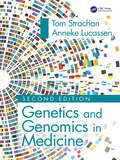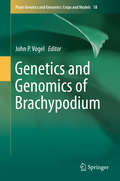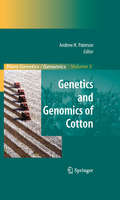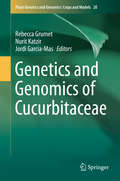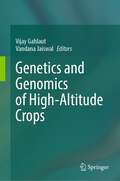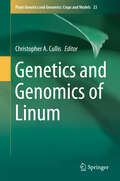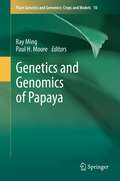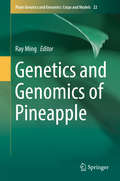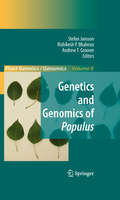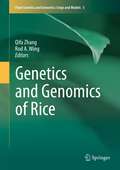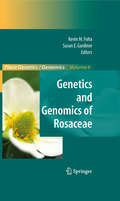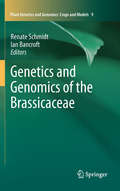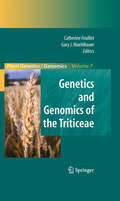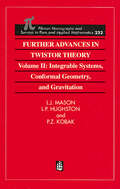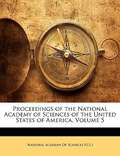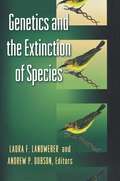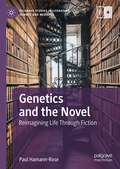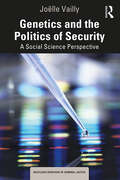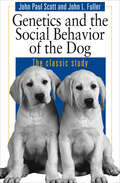- Table View
- List View
Genetics and Genomics in Medicine
by Tom Strachan Anneke LucassenThe second edition of this textbook written for undergraduate students, graduate students and medical researchers, Genetics and Genomics in Medicine explains the science behind the uses of genetics and genomics in medicine today, and how it is being applied.Maintaining the features that made the first edition so popular, this second edition has been thoroughly updated in line with the latest developments in the field. DNA technologies are explained, with emphasis on the modern techniques that are revolutionizing the use of genetic information in medicine and indicating the role of genetics in common diseases. Epigenetics and non-coding RNA are covered in-depth as are genetic approaches to treatment and prevention, including pharmacogenomics, genetic testing, and personalized medicine. A dedicated chapter charts the latest insights into the molecular basis of cancers, cancer genomics and novel approaches to cancer detection. Coverage of genetic testing at the level of genes, chromosomes and genomes has been significantly expanded and updated. Extra prominence has been given to additional genomic analyses, ethical aspects, and novel therapeutic approaches. Various case studies illustrate selected clinical applications.Key Features Comprehensive and integrated account of how genetics and genomics affect the entire spectrum of human health and disease Exquisite artwork illuminates the key concepts and mechanisms Summary points at the end of each chapter help to consolidate learning For each chapter, an abundance of further reading to help provide the reader with direction for further study Inclusive online question bank to test understanding Standard boxes summarizing certain key principles in genetics Clinical boxes summarizing selected case studies, pathogenesis mechanisms or novel therapies for selected diseases This book is equally suited for newcomers to the field as well as for engineers and scientists that have basic knowledge in this field but are interested in obtaining more information about specific future applications..
Genetics and Genomics of Brachypodium
by John P. VogelGrasses dominate many natural ecosystems and produce the bulk calories consumed by humans either directly in the form of grains or indirectly through forage/grain fed animals. In addition, grasses grown as biomass crops are poised to become a significant source of renewable energy. Despite their economic and environmental importance, research into the unique aspects of grass biology has been hampered by the lack of a truly tractable experimental model system. Over that past decade, the small, annual grass Brachypodium distachyon has emerged as a viable model system for the grasses. This book describes the development of extensive experimental resources (e. g. whole genome sequence, efficient transformation methods, insertional mutant collections, large germplasm collections, recombinant inbred lines, resequenced genomes) that have led many laboratories around the world to adopt B. distachyon as a model system. The use of B. distachyon to address a wide range of biological topics (e. g. disease resistance, cell wall composition, abiotic stress tolerance, root growth and development, floral development, natural diversity) is also discussed.
Genetics and Genomics of Cotton
by Andrew H. PatersonThe Gossypium (cotton) genus presents novel opportunities to advance our understanding of the natural world and its organic evolution. In this book, advances of the past decade are summarized and synthesized to elucidate the current state of knowledge of the structure, function, and evolution of the Gossypium genome, and progress in the application of this knowledge to cotton improvement. This book provides the first comprehensive reference on cotton genomics.
Genetics and Genomics of Cucurbitaceae
by Jordi Garcia-Mas Rebecca Grumet Nurit KatzirThis book provides an overview of the current state of knowledge of the genetics and genomics of the agriculturally important Cucurbitaceae plant family, which includes crops such as watermelon, melon, cucumber, summer and winter squashes, pumpkins, and gourds. Recent years have resulted in tremendous increases in our knowledge of these species due to large scale genomic and transcriptomic studies and production of draft genomes for the four major species, Citrullus lanatus, Cucumis melo, Cucumis sativus, and Cucurbita spp. This text examines genetic resources and structural and functional genomics for each species group and across species groups. In addition, it explores genomic-informed understanding and commonalities in cucurbit biology with respect to vegetative growth, floral development and sex expression, fruit growth and development, and important fruit quality traits.
Genetics and Genomics of High-Altitude Crops
by Vijay Gahlaut Vandana JaiswalThis edited book provides comprehensive coverage of the recent advances in genetics and genomics of high-altitude crops (HACs). This book also assists in understanding the genomic adaptation to the environmental extremes at high altitude conditions. High-altitude crops are challenged by several high-altitude specific environmental stresses, i.e., extensive UV-B irradiation, extremely low temperature and intense hypoxia. These environmental constraints would be expected to cause genomic variations in HACs. Several studies have been conducted to dissect genetic and genomic regions in HACs to cope up with environmental stresses. However, these types of studies were not compiled or summarized anywhere. This book is of interest to teachers, researchers, climate change scientists, capacity builders and policymakers. Also, the book serves as a valuable resource for undergraduate and graduate students of agriculture, crop biotechnology, and environmental sciences. Scientists and policymakers who are working on high-altitude crops will also find this to be a useful read.
Genetics and Genomics of Linum (Plant Genetics and Genomics: Crops and Models #23)
by Christopher A. CullisLinum (flax) is a genus of about 200 species in the flowering plant family Linaceae. The genus includes common flax, which is one of the best fibers to produce linen, the seeds to produce linseed oil and has health-related properties of flax in human and animal nutrition.This book describes the genetics and genomics of Linum including the development of extensive experimental resources (e.g. whole genome sequence, efficient transformation methods, insertional mutant collections, large germplasm collections, resequenced genomes) that have led much progress and its economic importance. The methods and use of Linum to address a wide range of applications (e.g. disease resistance, cell wall composition, abiotic stress tolerance, floral development, natural diversity) is also discussed.
Genetics and Genomics of Papaya
by Paul H. Moore Ray MingThis book reviews various aspects of papaya genomics, including existing genetic and genomic resources, recent progress on structural and functional genomics, and their applications in papaya improvement. Organized into four sections, the volume explores the origin and domestication of papaya, classic genetics and breeding, recent progress on molecular genetics, and current and future applications of genomic resources for papaya improvement. Bolstered by contributions from authorities in the field, Genetics and Genomics of Papaya is a valuable resource that provides the most up to date information for papaya researchers and plant biologists.
Genetics and Genomics of Pineapple (Plant Genetics and Genomics: Crops and Models #22)
by Ray MingThis book is the first comprehensive volume on the genetics and genomics of pineapple and provides an overview of the current state of pineapple research. Pineapple [Ananas comosus (L.) Merr.] is the second most important tropical fruit after banana in term of international trade. Its features are advantageous for genomic research: it has a small genome of 527 Mb which is diploid and vegetatively propagated; it is monocot, closely related to the grass family that includes major cereal crops, wheat, rice, corn, sorghum, and millet; and it serves as an out group for genetic and genomic research in grasses. In addition to exploring the evolution and improvement of pineapple, this work examines the pineapple genome with respect to genome structure and organization, comparative analyses with other angiosperm genomes, transcription factors, disease resistance, and circadian clock regulation of CAM related genes. With chapters covering botanical, genetic, genomic, and applied aspects of pineapple, this text also encourages the application of genomic technologies and suggests future prospects.
Genetics and Genomics of Populus
by Stefan Jansson Andrew Groover Rishikesh BhaleraoGenetics and Genomics of Populus provides an indepth description of the genetic and genomic tools and approaches for Populus, examines the biology that has been elucidated using genomics, and looks to the future of this unique model plant. This volume is designed to serve both experienced Populus researchers and newcomers to the field. Contributors to the volume are a blend of researchers, some who have spent most of their research career on Populus and others that have moved to Populus from other model systems. Research on Populus forms a useful complement to research on Arabidopsis. In fact, many plant species found in nature are - in terms of the life history and genetics - more similar to Populus than to Arabidopsis. Thus, the genetic and genomic strategies and tools developed by the Populus community, and showcased in this volume, will hopefully provide inspiration for researchers working in other, less well developed, systems.
Genetics and Genomics of Rice
by Qifa Zhang Rod A. WingThis book provides a comprehensive coverage of the advances in genetics and genomics research on rice. The chapters feature the latest developments in rice research and cover such topics as the tools and resources for the functional analysis of rice genes, the identification of useful genes for rice improvement, the present understanding of rice development and biological processes, and the application of this present understanding towards rice improvement. The volume also features a perspective on synthesis and prospects, laying the groundwork for future advances in rice genetics and genomics. Written by authorities in the field, Genetics and Genomics of Rice will serve as an invaluable reference for rice researchers for years to come.
Genetics and Genomics of Rosaceae
by Kevin M. Folta Susan E. GardinerThe Rosaceae Family is represented by approximately 3,000 species of diverse plants, primarily confined to temperate climates. The family has a rich variety of architectural forms and contains herbaceous, tree and shrub species. Many family members are readily recognizable because of their edible seasonal fruits that are prized for their unique flavors, colors and nutritious properties (e.g. apple, strawberry, raspberry, pear, cherry, plum, apricot, pear), as well as familiar ornamentals (e.g. roses) and nuts (e.g. almonds). This book covers progress in recent genomic research among the Rosaceae, grounding this firmly in the historical context of genetic studies and in the application of genomics technologies for crop development. A general introduction precedes summaries of genomics research and applications on a crop by crop basis, each authored by a panel of active researchers in each particular crop. This volume is a considerable value as a resource for workers in the Rosaceae operating at all levels, from research scientists in genetics, genomics and breeding, to graduate and undergraduate students.
Genetics and Genomics of the Brassicaceae
by Renate Schmidt Ian BancroftThe Genetics and Genomics of the Brassicaceae provides a review of this important family (commonly termed the mustard family, or Cruciferae). The family contains several cultivated species, including radish, rocket, watercress, wasabi and horseradish, in addition to the vegetable and oil crops of the Brassica genus. There are numerous further species with great potential for exploitation in 21st century agriculture, particularly as sources of bioactive chemicals. These opportunities are reviewed, in the context of the Brassicaceae in agriculture. More detailed descriptions are provided of the genetics of the cultivated Brassica crops, including both the species producing most of the brassica vegetable crops (B. rapa and B. oleracea) and the principal species producing oilseed crops (B. napus and B. juncea). The Brassicaceae also include important "model" plant species. Most prominent is Arabidopsis thaliana, the first plant species to have its genome sequenced. Natural genetic variation is reviewed for A. thaliana, as are the genetics of the closely related A. lyrata and of the genus Capsella. Self incompatibility is widespread in the Brassicaceae, and this subject is reviewed. Interest arising from both the commercial value of crop species of the Brassicaceae and the importance of Arabidopsis thaliana as a model species, has led to the development of numerous resources to support research. These are reviewed, including germplasm and genomic library resources, and resources for reverse genetics, metabolomics, bioinformatics and transformation. Molecular studies of the genomes of species of the Brassicaceae revealed extensive genome duplication, indicative of multiple polyploidy events during evolution. In some species, such as Brassica napus, there is evidence of multiple rounds of polyploidy during its relatively recent evolution, thus the Brassicaceae represent an excellent model system for the study of the impacts of polyploidy and the subsequent process of diploidisation, whereby the genome stabilises. Sequence-level characterization of the genomes of Arabidopsis thaliana and Brassica rapa are presented, along with summaries of comparative studies conducted at both linkage map and sequence level, and analysis of the structural and functional evolution of resynthesised polyploids, along with a description of the phylogeny and karyotype evolution of the Brassicaceae. Finally, some perspectives of the editors are presented. These focus upon the Brassicaceae species as models for studying genome evolution following polyploidy, the impact of advances in genome sequencing technology, prospects for future transcriptome analysis and upcoming model systems.
Genetics and Genomics of the Triticeae
by Catherine Feuillet Gary J. MuehlbauerSequencing of the model plant genomes such as those of A. thaliana and rice has revolutionized our understanding of plant biology but it has yet to translate into the improvement of major crop species such as maize, wheat, or barley. Moreover, the comparative genomic studies in cereals that have been performed in the past decade have revealed the limits of conservation between rice and the other cereal genomes. This has necessitated the development of genomic resources and programs for maize, sorghum, wheat, and barley to serve as the foundation for future genome sequencing and the acceleration of genomic based improvement of these critically important crops. Cereals constitute over 50% of total crop production worldwide (http://www.fao.org/) and cereal seeds are one of the most important renewable resources for food, feed, and industrial raw materials. Crop species of the Triticeae tribe that comprise wheat, barley, and rye are essential components of human and domestic animal nutrition. With 17% of all crop area, wheat is the staple food for 40% of the world's population, while barley ranks fifth in the world production. Their domestication in the Fertile Crescent 10,000 years ago ushered in the beginning of agriculture and signified an important breakthrough in the advancement of civilization. Rye is second after wheat among grains most commonly used in the production of bread and is also very important for mixed animal feeds. It can be cultivated in poor soils and climates that are generally not suitable for other cereals. Extensive genetics and cytogenetics studies performed in the Triticeae species over the last 50 years have led to the characterization of their chromosomal composition and origins and have supported intensive work to create new genetic resources. Cytogenetic studies in wheat have allowed the identification and characterization of the different homoeologous genomes and have demonstrated the utility of studying wheat genome evolution as a model for the analysis of polyploidization, a major force in the evolution of the eukaryotic genomes. Barley with its diploid genome shows high collinearity with the other Triticeae genomes and therefore serves as a good template for supporting genomic analyses in the wheat and rye genomes. The knowledge gained from genetic studies in the Triticeae has also been used to produce Triticale, the first human made hybrid crop that results from a cross between wheat and rye and combines the nutrition quality and productivity of wheat with the ruggedness of rye. Despite the economic importance of the Triticeae species and the need for accelerated crop improvement based on genomics studies, the size (1.7 Gb for the bread wheat genome, i.e., 5x the human genome and 40 times the rice genome), high repeat content (>80%), and complexity (polyploidy in wheat) of their genomes often have been considered too challenging for efficient molecular analysis and genetic improvement in these species. Consequently, Triticeae genomics has lagged behind the genomic advances of other cereal crops for many years. Recently, however, the situation has changed dramatically and robust genomic programs can be established in the Triticeae as a result of the convergence of several technology developments that have led to new, more efficient scientific capabilities and resources such as whole-genome and chromosome-specific BAC libraries, extensive EST collections, transformation systems, wild germplasm and mutant collections, as well as DNA chips. Currently, the Triticeae genomics "toolbox" is comprised of: - 9 publicly available BAC libraries from diploid (5), tetraploid (1) and hexaploid (3) wheat; 3 publicly available BAC libraries from barley and one BAC library from rye; - 3 wheat chromosome specific BAC libraries; - DNA chips including commercially available first generation chips from AFFYMETRIX containing 55'000 wheat and 22,000 barley genes; - A large number of wheat and barley genetic maps that are saturated by a significant number of markers; - The largest plant EST colle...
Genetics and Insurance
by T. McGleenan U. Wiesing F. EwaldCompiled by a well known and respected team of editors and contributors from interdisciplinary backgrounds, this book has its origins in the Euroscreen project, a research project funded by the European Commission to examine the legal and ethical issues arising from the use of genetic testing and screening since 1990. Contributors from members of a sub-group look at the likely impact of genetic testing on insurance.It will be published at a point when the significant controversy surrounding this issue will have intensified throughout the European Union. Although taking a European perspective, it addresses US issues where there is a strong interest in comparative legislative strategies, taking a themed approach, this book looks comprehensively at the basis issues with an analytical rather than a descriptive approach.
Genetics and Philosophy
by Paul Griffiths Karola StotzIn the past century, nearly all of the biological sciences have been directly affected by discoveries and developments in genetics, a fast-evolving subject with important theoretical dimensions. In this rich and accessible book, Paul Griffiths and Karola Stotz show how the concept of the gene has evolved and diversified across the many fields that make up modern biology. By examining the molecular biology of the 'environment', they situate genetics in the developmental biology of whole organisms, and reveal how the molecular biosciences have undermined the nature/nurture distinction. Their discussion gives full weight to the revolutionary impacts of molecular biology, while rejecting 'genocentrism' and 'reductionism', and brings the topic right up to date with the philosophical implications of the most recent developments in genetics. Their book will be invaluable for those studying the philosophy of biology, genetics and other life sciences.
Genetics and Randomness
by Anatoly RuvinskyAnalyzes Randomness in Major Genetic Processes and EventsNo matter how far science advances, the proportion of what is knowable to what is random will remain unchanged, and attempts to ignore this critical threshold are futile at best. With the revolutionary explosion in genetic information discovery, it is crucially important to recognize the unde
Genetics and The Origin of Species: From Darwin to Molecular Biology 60 Years After Dobzhansky
by National Academy Of SciencesPapers from a National Academy of Sciences Colloquium on Genetics and the Origin of Species<P> The National Academies Press (NAP)--publisher for the National Academies--publishes more than 200 books a year offering the most authoritative views, definitive information, and groundbreaking recommendations on a wide range of topics in science, engineering, and health. Our books are unique in that they are authored by the nation's leading experts in every scientific field.
Genetics and the Extinction of Species: DNA and the Conservation of Biodiversity
by Laura F. Landweber & Andrew P. DobsonDarwin's Origin of Species and Dobzhansky's Genetics and the Origin of Species have been the cornerstones of modern evolutionary and population genetic theory for the past hundred years, but in the twenty-first century, biologists will face graver problems of extinction. In this collection, a team of leading biologists demonstrates why the burgeoning field of conservation biology must continue to rely on the insights of population genetics if we are to preserve the diversity of living species. Technological and theoretical developments throughout the 1990s have allowed for important new insights into how populations have evolved in response to past selection pressures, while providing a broad new understanding of the genetic structure of natural populations. The authors explore these advances and argue for the applicability of new genetic methods in conservation biology. The volume covers such topics as the reasons for extinctions, the best ways to measure biodiversity, and the benefits and drawbacks of policies like captive breeding. Genetics and the Extinction of Species is a rich source of information for biologists and policymakers who want to learn more about the host of tools, theories, and approaches available for conserving biodiversity. In addition to the editors, the contributors to the volume are William Amos, Rebecca Cann, Kathryn Rodriguez-Clark, Leslie Douglas, Leonard Freed, Paul Harvey, Kent Holsinger, Russell Lande, and Helen Steers.
Genetics and the Manipulation of Life
by Craig HoldregeCovers all areas of genetics in simple terms. There are detailed descriptions of the figures contained in the book. Contains glossary and index.
Genetics and the Novel: Reimagining Life Through Fiction (Palgrave Studies in Literature, Science and Medicine)
by Paul Hamann-RoseGenetics and the Novel: Reimagining Life Through Fiction argues that literary fiction has reimagined life in the age of genetics. The new genetic paradigm has proposed to rewrite core assumptions about such fundamental aspects of life as the nature of kinship and biological connection, human-environmental relations, or the link between biology and art. Investigating major texts of genetic fiction by A. S. Byatt, Ian McEwan, Simon Mawer and Margaret Atwood, this monograph offers the first systematic study of how these assumptions about life itself have been renegotiated through the contemporary novel’s engagement with genetic science. This book identifies a significant new phase in the novel’s aesthetic exploration of life and demonstrates that the novel emerges as the cultural form uniquely positioned to engage both the imaginative and concrete challenges raised by genetic science for the lifeworlds of the new millennium.
Genetics and the Politics of Security: A Social Science Perspective (Routledge Frontiers of Criminal Justice)
by Joëlle VaillyPresenting a social science perspective on the contemporary gaze on the body of the suspect, this book considers how definitions of criminality, offenses, individual rights, and the concepts of identity and difference have been altered by changes in the biological status of the human.Spurred by rapid developments in genetics and information technology, a number of countries, including France, the United States, the United Kingdom, China, and the Netherlands, have considerably expanded their genetic databases used by the police and the criminal justice system. Whilst this makes it possible to compare DNA left at the scene of a crime with that of an individual known to the police, helping to identify individuals for the purposes of court proceedings, these innovations also raise a number of important questions, such as how the relationship between respect for the rights of individuals and the security of populations is discussed, as well as for how long this data should be retained. Genetic analysis also raises concerns related to phenotyping and “biogeographical origin” that could lead to the stigmatization of targeted groups.Offering a comprehensively argued view on how DNA acts not only as a tracker of suspicion but also as a marker of contemporary social developments, Genetics and the Politics of Security will appeal to students and scholars, judiciary personnel, lawyers, police officers, and people with an interest in criminology and the use of genetics in the criminal justice process.
Genetics and the Social Behavior of the Dog
by John Paul Scott John L. FullerThe classic study of canine behavior: &“A major authoritative work…Immensely rewarding reading for anyone concerned with dog-breeding.&”—Times Literary Supplement Based on twenty years of research at the Jackson Laboratory, this is the single most important and comprehensive reference work on the behavior of dogs ever compiled, written by geneticist and comparative psychologist John Paul Scott, known for his research into social behavior and aggression. &“One of the most important texts on canine behavior published to date. Anyone interested in breeding, training, or canine behavior must own this book.&”—Wayne Hunthausen, D.V.M., Director of Animal Behavior Consultations &“This pioneering research on dog behavioral genetics is a timeless classic for all serious students of ethology and canine behavior.&”—Dr. Michael Fox, Senior Advisor to the President, The Humane Society of the United States &“Comprehensive…[a] seminal work.&”—Mark Derr, The Atlantic Monthly &“Essential reading for anyone involved in the breeding of dogs. No breeder can afford to ignore the principles of proper socialization first discovered and articulated in this landmark study.&”—The Monks of New Skete, authors of How to Be Your Dog's Best Friend and the video series Raising Your Dog with the Monks of New Skete
Genetics for Healthcare Professionals: A Lifestage Approach
by Heather Skirton Christine PatchGenetics is increasingly important in health care provision, but its relevance on a day-to-day basis is often poorly understood. Genetics for Healthcare Professionals introduces the general principles of genetics and links these to real world examples, to allow nurses, midwives, genetic counselors and doctors to apply this knowledge in their routine clinical practice.The book takes an holistic family-oriented approach, from preconception to adulthood, and addresses the misconception that clinical genetics is only of relevance to those who are reproducing. Genetics for Healthcare Professionals is an essential textbook of genetics for nurses, midwives, genetic counselors and doctors. An ideal coursebook for students in the healthcare professions, it is also written for qualified staff seeking an update on current issues and how to apply them in practice.
Genetics in Human Reproduction (Routledge Revivals)
by Elisabeth Hildt Sigrid GraumannPublished in 1999, this book discusses issues related to the current and possible future technological progress in genetic technology linked to in vitro fertilization, specifically preimplantation diagnosis and germline gene therapy, from a scientific and medical as well as from a social, juridical and ethical point of view. The 31 contributions are divided into six sections medical and scientific view, personal interests and moral implications, moral rights and duties, social concepts and moral implications, choices and decision making, and justice in health care and legal regulation.
Genetics in Minutes
by Tom JacksonGenetics in Minutes is your compact and accessible guide to the central concepts of the science of genetics, revealing how our genes shape our bodies and our lives, and how in turn we are beginning to shape them. Covering the basics of DNA, inheritance and evolution in animals, plants and humans alike - from the origins and development of life to the Human Genome and designer babies - this is the fastest, fullest path to understanding genetics. Contents include Genes, DNA, Natural selection, Darwinism, Stem cell and gene therapies, Evo-devo, Epigenetics, Cloning, Genetic engineering and Artificial life, as well as biology basics such as the Processes of life, Cells, Sex, Classification and Ecology.
